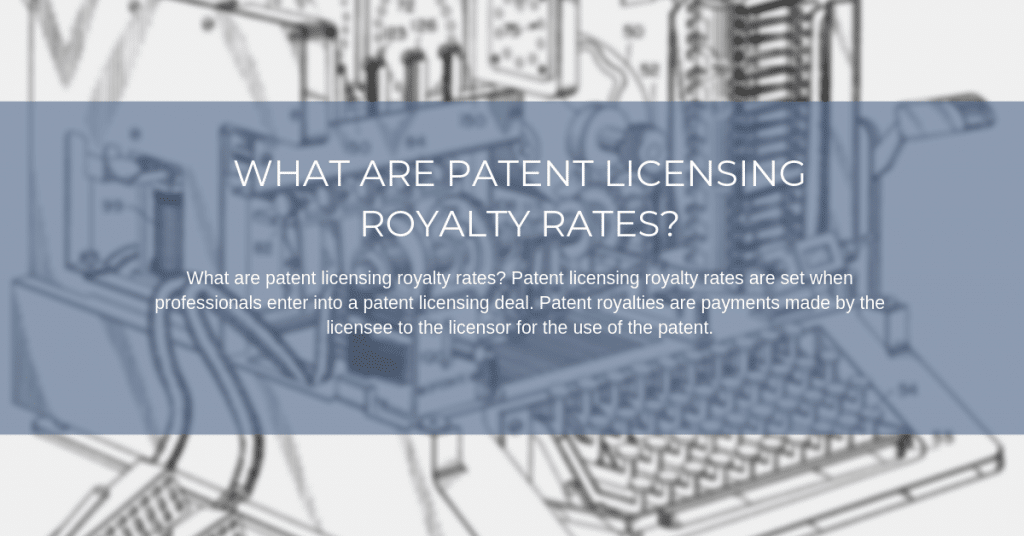What are patent licensing royalty rates?
October 15, 2019

What are patent licensing royalty rates? Patent licensing royalty rates are set when professionals enter into a patent licensing deal. Patent royalties are payments made by the licensee to the licensor for the use of the patent. They are usually a percentage of the revenue generated by the patent, although they can sometimes be agreed as a fixed fee. The whole point of patent royalty rates is to ensure that the inventor is fairly compensated for the use of their intellectual property.
In this article, we’ll outline:
- When patent royalties are used
- Factors affecting patent licensing royalty rates
- Patent licensing agreements
- How to set fair patent royalty rates
- Using patent royalties to set transfer pricing
When are patent licensing royalty rates used?
Usually, inventors enter into a licensing deal to let another organization take care of developing, manufacturing or commercializing their invention. This lets the invention be as productive as possible, without the inventor having to manage it. The licensee can use the invention to boost their business activities, without having to spend the time inventing a new product or technology. By setting royalty rates as a percentage of revenue generated by the patent, both sides benefit fairly from the deal. The licensor is compensated in line with how much value their patent brings, and the licensee’s payments are proportional to how much revenue the patent is generating.
Patent licensing agreements
Patent royalty rates are outlined in a patent royalty agreement, which is signed by both parties. This clarifies the terms of the license and where, how and when the licensee can use the patent.
For more information on this, see our overview of patent royalty agreements.
You can also download real patent license agreement examples from our website (simply type ‘patent’ into the search bar to quickly locate the relevant agreements).
Factors affecting patent licensing royalty rates
There are a number of factors that can affect what rate can be reasonably proposed for patent royalties. These include:
- Whether the licensee has paid upfront compensation
- What stage the patent is at
- The patented invention’s market potential
- The industry
- The level of competition in the market
- The market size
- How unique the invention is
- The exclusivity of the patent license
As such, when it comes to determining fair royalty rates, the above factors must be taken into account. Whether you are analyzing transfer pricing, setting royalty rates for a license agreement or valuing a patent, the rate you set needs to reflect the individual circumstances of the patent.
How to set fair patent royalty rates
When it comes to setting patent licensing royalty rates, there’s no room for guesswork – you need to calculate fair royalties based on income, costs or comparable market rates. Royalty rates can be anything from 0.1% to 25%, and they can differ from product to product and industry to industry.
You can use industry averages as a guideline, but make sure you’re backing these up with real, recent royalty rates data from reliable sources, such as our RoyaltyRange benchmarking studies.
Most licensing professionals rely on three main methods to work out royalty rates for a patent:
- The income approach: This estimates the income the patent will generate and bases the royalty rate on that.
- The market approach: This bases the royalty rate on the royalties charged for comparable patents in the market.
- The cost approach: This involves working out the cost of producing a similar patented asset, and basing the royalty on that.
Whichever royalty calculation method you use, you should always check your rates against comparable market rates, which you can find by using the RoyaltyRange royalty rates database.
Remember, royalty rates are usually calculated as a percentage of the gross or net revenue generated by the patent. However, they can also be agreed as a fixed fee. In some cases, tiered royalties can be used, which is when the royalty percentage changes depending on certain criteria being met – for example, the royalty rates may get lower if certain sales volumes are reached.
For more information on all this, see our blog on how royalties are calculated.
Using patent royalties to set transfer pricing
If you are carrying out a transfer pricing analysis for a transaction involving patents, you can use third-party patent royalty rates data to guide your calculations. By looking at the royalty rates set for comparable uncontrolled transactions, you can work out if the transfer pricing is at arm’s length.
There are five main methods for determining arm’s length transfer prices. These are:
- The comparable uncontrolled price method (CUP method)
- The resale price method
- The cost plus method
- The transactional net margin method (TNMM)
- The transactional profit split method
The OECD says that the CUP method is the most direct way to apply the arm’s length principle when reliable comparables data is available. It involves looking at what would have been earned had the transaction been carried out between two unrelated parties – hence why third-party royalty rates data is so useful. You can find more information about this in our blog on the CUP method.
Whatever method you use for your transfer pricing analysis, you can find the third-party patent royalty rates you need in the RoyaltyRange royalty rates database.
Get the latest patent licensing royalty rates
Here at RoyaltyRange, we provide you with access to the latest royalty rates from patent licensing agreements across hundreds of industries, markets and product types.
This market data is invaluable if you’re negotiating patent royalty rates for a license agreement, valuing a patented product or analyzing an intercompany transaction for transfer pricing purposes.
The best thing about it is that we do all the hard work. You tell us what sort of data you need, and we conduct the search and present our findings back to you in a concise, easy-to-read report.
Here are your options:
- Request a royalty rates report: This is our One Search service, where you tell us your search criteria and we conduct a one-off royalty rates search on your behalf.
- Order a benchmarking study: Based on your search criteria, we produce a comparison of comparable agreements, including the median average and interquartile range.
Use the boxes on the right to get started.
Request One Search
We will perform the search and deliver the initial results within hours, at no cost.




